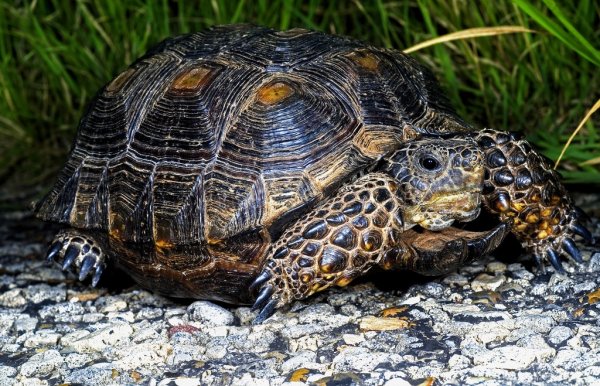ANIMAL: Texas Tortoise Gopherus berlandieri Type of Animal: Tortoise Habitat: Semidesert, desert, xeric shrubland, humid subtropical scrub woodland/forest, dry scrub, grasslands, dry savanna, well drained sandy soil areas, open scrub woodland, arid brushland, scrubland, thornscrub, dry forest Location(s): S Texas & NE Mexican states of Tamaulipas, Coahuila, Nuevo Leon, & NE San Luis Potosi Appearance: Rounded broad long carapace (upper shell) ranging from tan to dark brown to yellowish-orange, rigid plastron (lower shell), stumpy elephantine feet/legs, males have more elongated/forked/curvy gular projections in most anterior part of plastron, males have longer narrower carapace, concave plastron, & longer tail Food/Diet: Grasses, herbs, vegetables, prickly pear, cacti, succulents, weeds, flowers, leaves, fruit, gourds, melons, berries, greens, animal bones, poop, insects, snails, grubs Status in Wild: Stable Conservation: Breeding in zoos & breeding centers. Protected by Texas state law. Lifestyle: Solitary or small herds of a male w/ 2-4 females Additional Info: Called: Male Female Young: Hatchling Group: Herd/Bale Weight: Male: 7-9 lbs Female: 5-7 lbs Young: 2 oz Gestation: 3-4 months Life Span: 40-60 years Height: Male: 6 in Female: 4 in Body Length: Male: 8 in Female: 6 in Young: 4 in Tail Length: Male: Longer/Curvier Female: Shorter/Stubbier Main predators of adults are canids, felids, eagles, hawks, large owls, ravens, badgers, raccoons, & pigs. Smaller owls, falcons, skunks, weasels, roadrunners, rats, fire ants, ground squirrels, snakes, opossums, loggerhead shrikes, crows, jays, & armadillos prey on young. Sexually mature at 10 years old. They don’t drink much because they obtain most moisture from food eaten. While stable, potential threats are pet trade, collecting from wild, low reproductive rate, road collisions, development, habitat loss, intensive agriculture, & diseases/infections. Also called Berlandier’s Tortoise & Tortuga de Tamaulipas. Only tortoise species found in Texas. Mostly diurnal but bimodal in hot summer, active in early morning & late afternoon. Often hibernate in winter. Breed from June-September. Males sometimes fight to death by trying to turn each other over. Smallest N American tortoises. Females usually lay 2-7 eggs, laying 1-2 clutches a year. Fun Fact(s): Used to be very popular pets & in late 1950s & early 1960s were sold for as little as $5 apiece. When stressed/threatened/picked up, they’ll pee as last-resort defense mechanism. Unlike other Gopherus species, they don’t dig burrows. Instead, they use front legs & shell sides to push away soil/debris making shallow resting places called pallets, which aren’t normally deeper than 4.92 ft. However, they’ll sometimes use mammal burrows & further excavate them to own liking.

